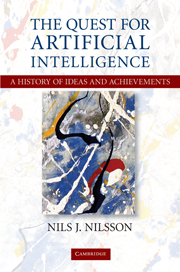Book contents
- Frontmatter
- Contents
- Preface
- PART I BEGINNINGS
- PART II EARLY EXPLORATIONS: 1950S AND 1960S
- PART III EFFLORESCENCE: MID-1960S TO MID-1970S
- PART IV APPLICATIONS AND SPECIALIZATIONS: 1970s TO EARLY 1980s
- 17 Speech Recognition and Understanding Systems
- 18 Consulting Systems
- 19 Understanding Queries and Signals
- 20 Progress in Computer Vision
- 21 Boomtimes
- PART V “NEW-GENERATION” PROJECT
- PART VI ENTR'ACTE
- PART VII THE GROWING ARMAMENTARIUM: FROM THE 1980s ONWARD
- PART VIII MODERN AI: TODAY AND TOMORROW
- Index
- Plate section
19 - Understanding Queries and Signals
Published online by Cambridge University Press: 05 August 2013
- Frontmatter
- Contents
- Preface
- PART I BEGINNINGS
- PART II EARLY EXPLORATIONS: 1950S AND 1960S
- PART III EFFLORESCENCE: MID-1960S TO MID-1970S
- PART IV APPLICATIONS AND SPECIALIZATIONS: 1970s TO EARLY 1980s
- 17 Speech Recognition and Understanding Systems
- 18 Consulting Systems
- 19 Understanding Queries and Signals
- 20 Progress in Computer Vision
- 21 Boomtimes
- PART V “NEW-GENERATION” PROJECT
- PART VI ENTR'ACTE
- PART VII THE GROWING ARMAMENTARIUM: FROM THE 1980s ONWARD
- PART VIII MODERN AI: TODAY AND TOMORROW
- Index
- Plate section
Summary
The Setting
Up until about the mid-1970s, DARPA managers were able to cushion the impact of the Mansfield Amendment (which required that Defense Department research be relevant to military needs) by describing computer research programs in a way that emphasized applications. Larry Roberts, the Director of DARPA's IPTO during the late 1960s and early 1970s, wrote
The Mansfield Amendment created a particular problem during my stay at DARPA. It forced us to generate considerable paperwork and to have to defend things on a different basis. It made us have more development work compared to the research work in order to get a mix such that we could defend it. I don't think I had to drop a project in our group due to the Mansfield Amendment, however. We could always find a way to defend computer science …
The formal submissions to Congress for AI were written so that the possible impact was emphasized, not the theoretical considerations.
Cordell Green, working under Roberts at IPTO, wrote
Generally speaking, anything that came along in the AI field that we thought looked good was Supported…
One of my jobs was to defend the AI budget but that wasn't terribly difficult … all sorts of computer science is relevant because it will have a high impact on any large information-processing organization, and the Defense Department is certainly such an organization … all of this research should be kept alive because it had potential military relevance.
- Type
- Chapter
- Information
- The Quest for Artificial Intelligence , pp. 244 - 257Publisher: Cambridge University PressPrint publication year: 2009



